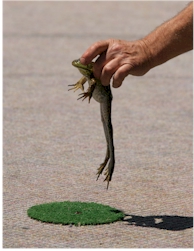



|
|
||
|
 |
|
|
|
Calaveras County sits in the rolling
foothills of the Sierra Nevada mountains. It was the heart of gold
rush country in the 1800s.
Mark Twain had a cabin on Jackass Hill, near Angels Camp in Calaveras County. He stayed there when prospecting for gold or when vacationing away from San Francisco city life. |
|
|
In 1848, Angels Camp, California was founded by one Henry Angel. At the height of the 1850s gold rush, the small tent town bustled with nearly 4,000 eager gold miners. In 1865 a young, unknown Mark Twain visited Angels Camp, staying in his cabin on Jackass Hill. It was in an Angels Camp tavern that he reportedly first heard the amusing frog jump tale. He wrote it down and called it "The Celebrated Jumping Frog of Calaveras County." He sent it in to his publisher in San Francisco, who printed it soon after. The story caught on, and leapt into newsprint across America and overseas. Dan'l Webster the jumping frog made Mark Twain a household name well before Huckleberry Finn did. In 1927, the small mining town of Angels Camp was still that. The main street that ran through the rustic downtown was still nothing more than a bumpy dirt road rutted by wagon wheels. The residents finally became fed up with the sorry state of the road and passed a bond measure to finance the paving of Main Street. The work was soon done and the street was smooth. The Angels Camp Boosters, a long-standing community organization, decided to celebrate Main Street's modernization in 1928. The festival's theme was based on Mark Twain's story, and a real frog jump was held downtown on the street itself. Between 10,000 and 15,000 people showed up for the event. Louis Fisher of Stockton jockeyed "The Pride of San Joaquin" 3' 6" to establish the first World Record. From those beginnings arose the world-renowned Jumping Frog Jubilee that occurs every year in Angels Camp, along with the Calaveras County Fair. Dignitaries, movie stars, and even foreign frogs have flown in to participate in past decades. Some 40,000 people now attend the fair every third weekend in May, and 2,000 frog jumps take place. Lee Giudici and "Rosie the Ribiter" hold the current World Record of 21' 5.75", established in 1986. Not without its controversy, the jump has attracted attention from animal rights activists over the nature of jumping frogs for recreation as well as the treatment of the frogs. In 1995 the Board of Directors of the 39th District Agricultural Association adopted a “Frog Welfare Policy” to formalize the Jubilee's commitment to treating the frogs humanely. The "professional" frog teams take great care in returning all of their wild-caught frogs to the same canals and ponds where they came from, and they keep frogs from different areas separated while in captivity to reduce the chance of spreading disease. Calaveras County's Jumping Frog Research Institute maintains that despite well-intentioned safeguards, the sheer number of frogs brought to jump at the Jubilee can still lead to disease spread without further measures. The Institute is also working to restore populations of the native, endangered California Red Legged Frog that likely inspired Twain's story, while the more prevalent bullfrogs (originally introduced from East of the Rocky Mountains) are now jumped in the Jubilee. |
||
|
For more background
on the Jumping Frog Jubilee visit
www.frogtown.org, the official site of the fair and the frog jump.
Visit www.jumpingfrog.org for
more information on the Jumping Frog Research Institute and its efforts to
protect native amphibian species. Also visit the
Declining Amphibian
Population Task Force, devoted to research on and protection of
amphibians worldwide.
|
||
|
|
||